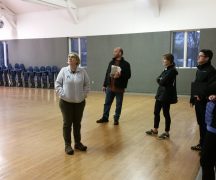By JAN LARSON McLAUGHLIN
BG Independent News
COVID relief funds may be used to keep the city pool budget afloat this summer – and keep pool patrons from having to pay more.
The Bowling Green Parks and Recreation Board agreed Monday evening to ask City Council for a minimum of $16,000 from American Rescue Plan Act funds to help meet increasing costs at the pool.
The pool budget took some hits during COVID, and is now facing increased operating costs. The board was faced with the options of keeping pool rates the same in hopes that more people patronize the pool this summer – or increasing seasonal pass or daily rates.
But then the possibility of using COVID relief funds was suggested by Mayor Mike Aspacher.
“I for one was grateful to hear that was an option for this year,” parks and recreation board member Emily Keegan said during Monday’s meeting.
The board agreed to ask for the ARPA funding, rather than increasing rates for pool patrons.
“Hopefully if everything works out, this would give some relief to families,” board President Jodi Anderson said.
City Council member Bill Herald said he supported the COVID relief funds being used to meet pool expenses.
“It’s an appropriate use of ARPA funds,” Herald said, noting that many families have seen their incomes decreased and costs increased. He also mentioned the therapeutic value of the swimming pool.
“This would mean less of a hit for those who really need help,” Herald said.
By using COVID relief funds, the park and rec board would have more time to gauge the post-COVID attendance trends at the pool, before making any decisions to increase pass or daily rates, Keegan said.
If the ARPA funds are not approved by City Council, pool rates may be increased.
A “very, very conservative” estimate for pool expenses this summer shows it will cost the city at least $16,000 more to operate the pool, according to Kristin Otley, director of the parks and recreation department.
The biggest new expense will be from the 50 cent an hour increase in Ohio’s minimum wage to $9.30 an hour – expected to add about $9,000 to pool expenses. Though not all pool staff are paid minimum wage, the incremental increase will be seen across the board.
Then there is the cost of chlorine, which the city has been informed will cost an additional 41 cents per gallon. That will add an estimated $4,000 to the pool expenses.
And there’s the concession supplies, which are predicted to cost 30% more than last year’s snacks.
The last time daily pool pass rates were increased was in 2019, when the board decided to raise the daily admission for non-residents by 50 cents
In February, Otley presented three rate options to the park and rec board:
- No change in rates. It’s possible the pool can regain some revenue if attendance returns to pre-COVID numbers.
- Increase the non-resident daily fee by 50 cents for children, and 75 cents for youth and adults. At the same time, season pass rates would be raised by $3 to $5 for residents, and $10 to $19 for non-residents. Past pass holders would be given a chance to buy season passes for the same price as last year if they are purchased by a certain date.
- The final option includes the rate increases addressed in the previous option, plus adding another 25 cents to the daily pass rate for residents.
The current daily rates for city residents have not been raised since the new pool facility opened in 2013, Otley said. The rates are $3.75 per child, $5.50 per youth, and $6 per adult.
The pool rates are higher for non-residents of Bowling Green. “They don’t pay property taxes here,” Otley said.
During the January park board meeting, Program Coordinator Ivan Kovacevic explained the trends experienced at the pool in the last few years – excluding 2020 when the pool was closed due to COVID restrictions. Some of the trends noticed were:
- Season pass users dropped from 26,771 in 2018, to 18,774 in 2019, then 16,142 in 2021. The drop last year was expected due to COVID concerns.
- Daily users have dropped from 21,164 in 2018, to 20,653 in 2019, then 16,786 in 2021. The number of people coming in on daily passes varies greatly depending on the weather.
- The total visitors went from 47,935 in 2018, to 39,427 in 2019, then 32,928 in 2021.
A program is already in place to help families unable to afford season pool passes by cutting the cost to 50% of the normal rate. Last year a “splash fund” was created to offer additional help to local families.
“There’s that safety net,” Otley said. “We want to make sure kids in the community can use the pool.”





